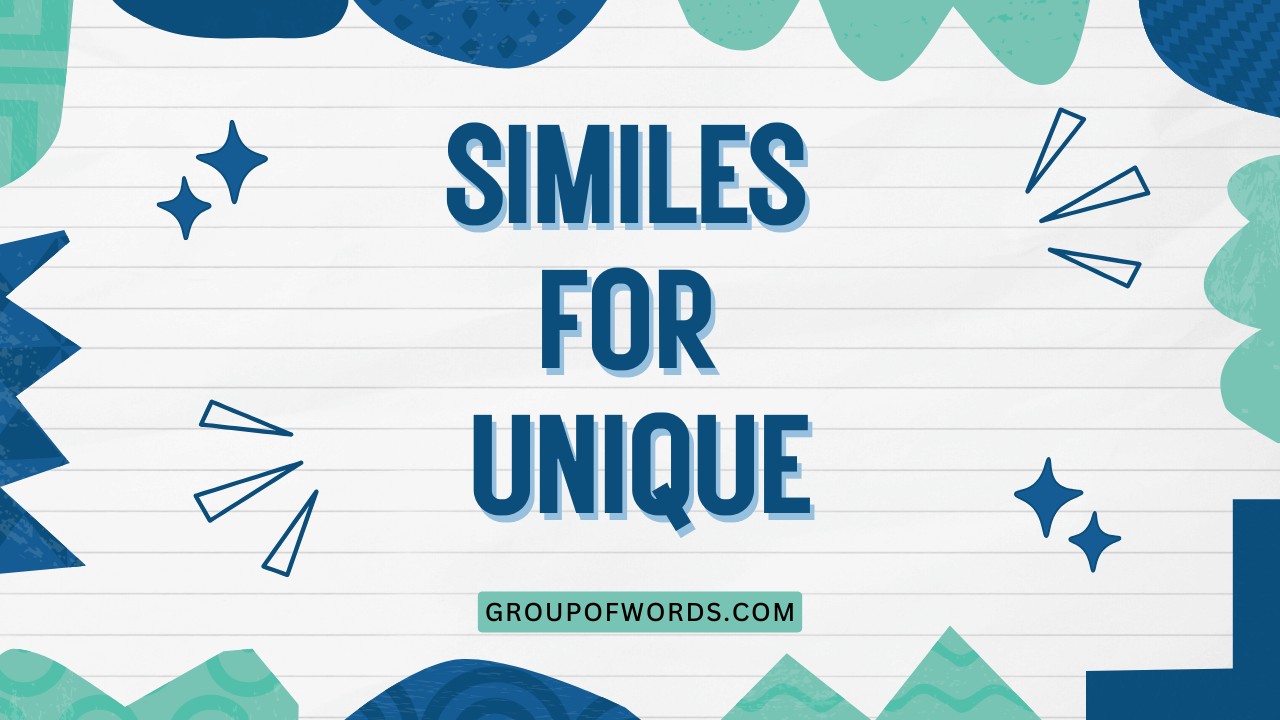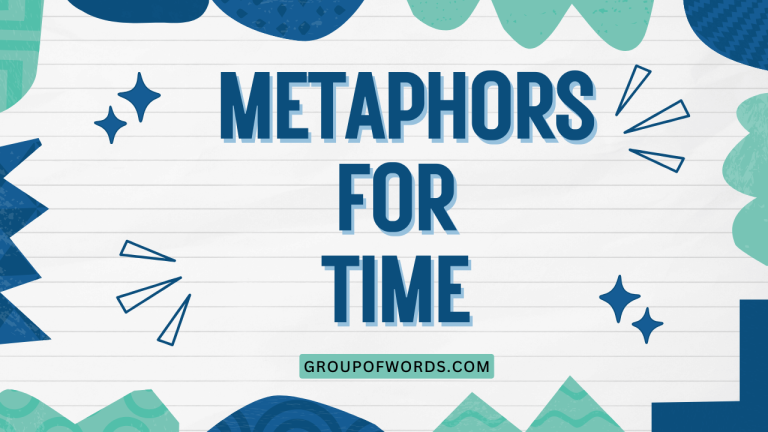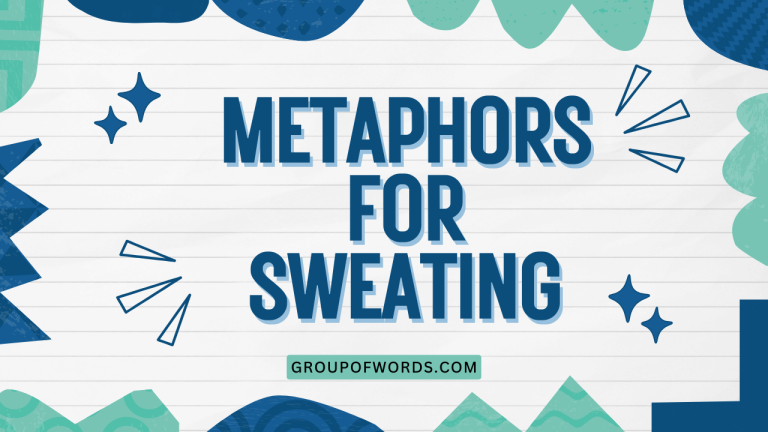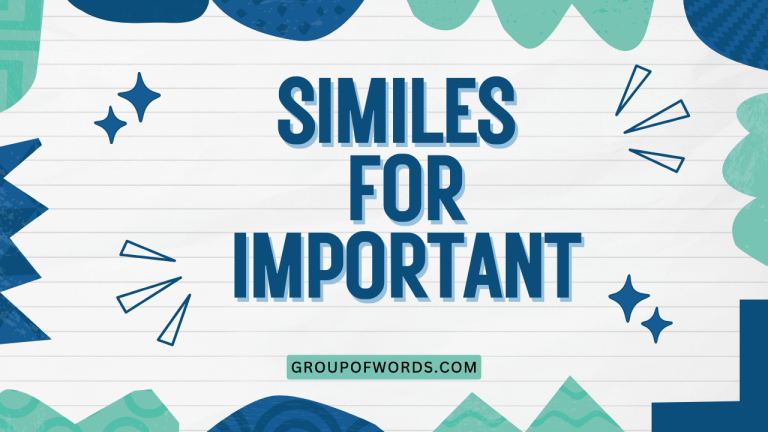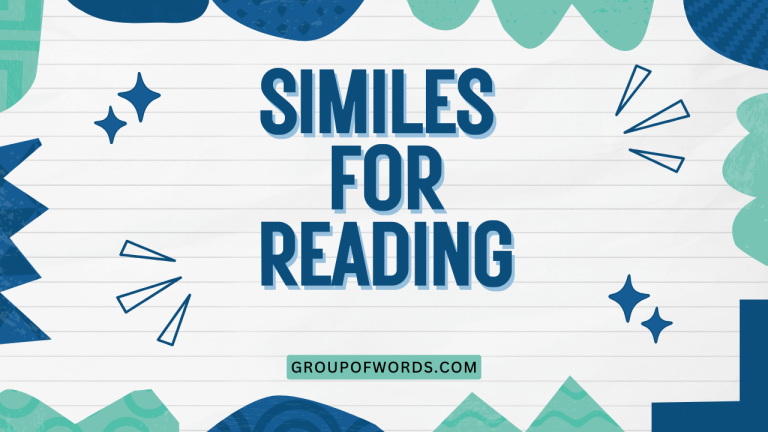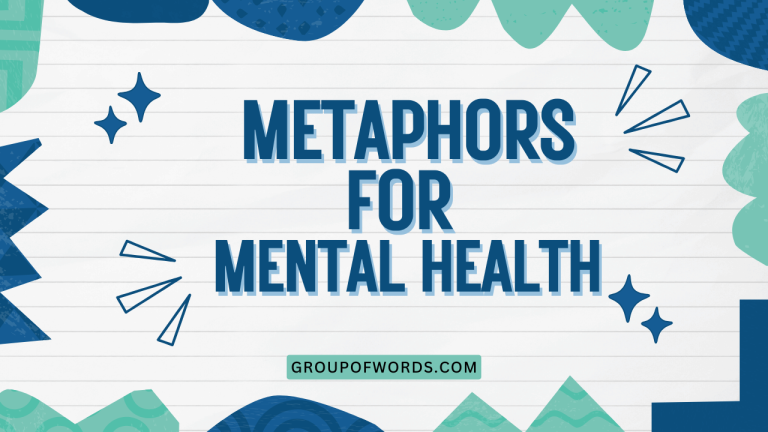Similes for Unique: Enhancing Your Descriptive Language
Understanding and using similes effectively is crucial for adding color and depth to your writing and speech. When describing something as “unique,” similes can elevate your language, making it more engaging and vivid.
This article provides a comprehensive guide to using similes for “unique,” offering definitions, examples, usage rules, and practice exercises. Mastering this skill will significantly improve your ability to craft compelling and imaginative descriptions, benefiting students, writers, and anyone looking to enhance their communication skills.
Table of Contents
- Introduction
- Definition of Simile and Uniqueness
- Structural Breakdown of Similes
- Types of Similes for Unique
- Examples of Similes for Unique
- Usage Rules for Similes
- Common Mistakes When Using Similes
- Practice Exercises
- Advanced Topics in Similes
- Frequently Asked Questions
- Conclusion
Introduction
Similes are powerful tools in the English language that allow us to draw comparisons between seemingly different things, enriching our descriptions and enhancing clarity. When aiming to convey the exceptional nature of something, using similes to describe “unique” qualities can be particularly effective.
This article delves into the art of crafting and understanding similes that capture the essence of uniqueness, providing a broad range of examples, practical guidelines, and exercises to solidify your understanding. By exploring various facets of simile usage, you’ll be equipped to add flair and precision to your communication, making your writing and speech more memorable and impactful.
Definition of Simile and Uniqueness
A simile is a figure of speech that directly compares two different things using “like” or “as.” The purpose of a simile is to illuminate or emphasize a particular quality shared by the two things being compared. It adds descriptive power and helps the reader or listener visualize the subject more effectively. For instance, saying “He is as brave as a lion” uses a simile to highlight the person’s bravery by associating it with the well-known courage of a lion.
Uniqueness, in this context, refers to the quality of being the only one of its kind, unparalleled, or distinctly different from others. Something that is unique possesses characteristics that set it apart and make it stand out. When we use similes to describe uniqueness, we aim to convey this sense of exceptional distinctiveness by comparing the unique entity to something else that embodies a similar level of exceptionality or rarity.
Classification
Similes are classified under the broader category of figurative language, which includes metaphors, personification, and other literary devices. They are specifically a type of comparison, designed to highlight similarities between two different subjects. Similes are often used in both formal and informal contexts to enhance descriptions and create vivid imagery.
Function
The primary function of a simile is to provide a more engaging and understandable description by drawing a comparison to something familiar. When describing uniqueness, similes help the audience grasp the unparalleled nature of the subject.
They can evoke emotions, create mental images, and add depth to the description, making it more memorable and impactful. Similes transform abstract concepts into more concrete and relatable terms.
Contexts
Similes are used in various contexts, including literature, poetry, everyday conversation, and professional writing. In literature and poetry, they are often used to create vivid imagery and enhance the artistic quality of the work.
In everyday conversation, similes can add color and humor to speech. In professional writing, they can be used to explain complex concepts in a more accessible way.
For example, a scientist might explain a new discovery using a simile to relate it to something the general public already understands.
Structural Breakdown of Similes
A simile typically consists of three main components: the subject, the comparison word (“like” or “as”), and the object of comparison. Understanding these components is crucial for constructing effective similes that accurately convey the intended meaning.
The subject is what is being described, the comparison word establishes the connection, and the object of comparison provides the relatable element that illuminates the subject’s qualities.
Subject
The subject is the entity you are describing. In the context of uniqueness, this is the thing that possesses qualities that set it apart.
It could be a person, object, idea, or concept. The subject is the focal point of the simile, and the comparison is designed to highlight its unique attributes.
For example, in the simile “Her talent was like a shooting star,” the subject is “her talent.”
Comparison Word (“like” or “as”)
The comparison word, either “like” or “as,” is the linchpin of the simile. It explicitly states that a comparison is being made between the subject and the object of comparison.
The choice between “like” and “as” is often a matter of stylistic preference, but both serve the same grammatical function. They signal to the reader that the description is not literal but figurative.
For example, using “as” in “As unique as a snowflake” indicates a comparison between the subject and the uniqueness of a snowflake.
Object of Comparison
The object of comparison is the entity to which the subject is being compared. This object should possess a quality that helps to illuminate the unique characteristic of the subject.
The effectiveness of the simile depends on the audience’s familiarity with the object of comparison and its associated qualities. For example, comparing something to a “rare gem” as in “As unique as a rare gem” helps the audience understand its value and exceptional nature.
Types of Similes for Unique
Similes used to describe uniqueness can be categorized based on the specific aspect of uniqueness they emphasize. These categories include rarity, distinctiveness, exceptionality, and originality.
Understanding these different types allows for more precise and nuanced descriptions.
Rarity
Similes emphasizing rarity highlight the uncommon or infrequent nature of the subject. They compare the subject to something else that is known for its scarcity.
These similes often use objects or concepts that are difficult to find or obtain, reinforcing the idea that the subject is one of a kind. Examples include comparing something to a “needle in a haystack” or a “four-leaf clover.”
Distinctiveness
Similes emphasizing distinctiveness focus on the qualities that set the subject apart from others. They compare the subject to something that is easily recognizable and unlike anything else.
These similes often use objects or concepts that have unique and identifiable characteristics. Examples include comparing something to a “fingerprint” or a “signature.”
Exceptionality
Similes emphasizing exceptionality highlight the outstanding or superior qualities of the subject. They compare the subject to something that is known for its excellence or extraordinary nature.
These similes often use objects or concepts that represent the pinnacle of achievement or skill. Examples include comparing something to a “masterpiece” or a “lightning strike.”
Originality
Similes emphasizing originality focus on the innovative or novel nature of the subject. They compare the subject to something that is new, inventive, or groundbreaking.
These similes often use objects or concepts that represent the cutting edge of creativity or technology. Examples include comparing something to a “prototype” or a “first edition.”
Examples of Similes for Unique
Here are several examples of similes used to describe uniqueness, categorized by the aspect of uniqueness they emphasize. These examples aim to provide inspiration and demonstrate the versatility of similes in conveying the concept of uniqueness.
Rarity Examples
The following table illustrates similes that emphasize the rarity of something. Each example compares the subject to something that is scarce or difficult to find, highlighting its unique and uncommon nature.
| Simile | Explanation |
|---|---|
| As rare as hen’s teeth | Emphasizes extreme rarity, as hens do not have teeth. |
| Like a needle in a haystack | Highlights the difficulty of finding something due to its scarcity. |
| As unique as a snowflake | Each snowflake is different, signifying individual uniqueness. |
| Like finding water in the desert | Shows the rarity and preciousness of the subject. |
| As scarce as honesty in politics | Humorously emphasizes the rarity of honesty in a specific context. |
| Like a blue moon | Refers to something that happens very infrequently. |
| As uncommon as a solar eclipse | Highlights the infrequent and special nature of the subject. |
| Like a vintage wine | Indicates rarity, age, and exceptional quality. |
| As precious as a lost artifact | Emphasizes the value and rarity of the subject. |
| Like a diamond in the rough | Shows potential and hidden rarity. |
| As unique as a fingerprint | Highlights individual distinctiveness and rarity. |
| Like a four-leaf clover | Indicates good luck and rarity. |
| As strange as a unicorn | Emphasizes the mythical and rare nature of the subject. |
| Like a shooting star | Highlights the fleeting and rare beauty of the subject. |
| As exceptional as a Nobel laureate | Emphasizes the outstanding and rare achievement of the subject. |
| Like a hidden treasure | Shows the rarity and value of something that is not easily found. |
| As unique as a handwritten letter | Highlights the personal and rare touch in a digital age. |
| Like an original painting | Indicates the one-of-a-kind nature of the subject. |
| As rare as a selfless act | Emphasizes the uncommon and commendable nature of the subject. |
| Like a genuine smile | Shows the rarity and sincerity of the subject. |
| As unusual as a talking parrot | Highlights the unexpected and rare nature of the subject. |
| Like a perfect pearl | Indicates the rarity and beauty of the subject. |
| As unique as a birthmark | Emphasizes individual distinctiveness and rarity. |
| Like a one-of-a-kind antique | Shows the historical value and rarity of the subject. |
Distinctiveness Examples
The following table provides similes that emphasize the distinctiveness of something. Each example compares the subject to something with unique and identifiable characteristics, highlighting its individual and unparalleled nature.
| Simile | Explanation |
|---|---|
| As distinct as a zebra’s stripes | Highlights the unique and easily identifiable pattern. |
| Like a signature melody | Emphasizes the recognizable and unique style. |
| As individual as a snowflake’s pattern | Highlights the unique and intricate design. |
| Like a custom-made suit | Shows the tailored and unique fit of the subject. |
| As recognizable as a brand logo | Emphasizes the distinctive and memorable nature. |
| Like a personal style | Indicates the individual and unique expression. |
| As unique as a human voice | Highlights the distinct and identifiable sound. |
| Like a rare bird’s call | Emphasizes the unique and recognizable sound. |
| As distinct as a painting by Van Gogh | Highlights the unique artistic style and recognizable technique. |
| Like a custom-designed car | Shows the tailored and unique features of the subject. |
| As recognizable as a famous landmark | Emphasizes the distinctive and iconic nature. |
| Like a personal brand | Indicates the individual and unique identity. |
| As unique as a family crest | Highlights the distinct and identifiable symbol. |
| Like a rare butterfly’s wings | Emphasizes the unique and intricate pattern. |
| As distinct as a dialect | Highlights the unique and recognizable speech pattern. |
| Like a custom-built house | Shows the tailored and unique design of the subject. |
| As recognizable as a national flag | Emphasizes the distinctive and symbolic nature. |
| Like a personal trademark | Indicates the individual and unique identifier. |
| As unique as a genetic code | Highlights the distinct and identifiable blueprint. |
| Like a rare flower’s scent | Emphasizes the unique and recognizable aroma. |
| As distinct as a cultural tradition | Highlights the unique and recognizable custom. |
| Like a custom-engraved piece | Shows the tailored and unique detail of the subject. |
| As recognizable as a company slogan | Emphasizes the distinctive and memorable phrase. |
| Like a personal mantra | Indicates the individual and unique affirmation. |
Exceptionality Examples
The following table illustrates similes that emphasize the exceptionality of something. Each example compares the subject to something that is outstanding or superior, highlighting its remarkable and extraordinary nature.
| Simile | Explanation |
|---|---|
| As exceptional as a virtuoso performance | Highlights the outstanding skill and artistry. |
| Like a masterpiece in a museum | Emphasizes the artistic excellence and value. |
| As extraordinary as a record-breaking achievement | Highlights the unparalleled and remarkable accomplishment. |
| Like a once-in-a-lifetime opportunity | Shows the rare and exceptional chance. |
| As outstanding as a gold medal winner | Emphasizes the superior performance and achievement. |
| Like a top-tier professional | Indicates the highest level of skill and expertise. |
| As remarkable as a scientific breakthrough | Highlights the significant and groundbreaking discovery. |
| Like a legendary hero’s feat | Emphasizes the extraordinary and memorable action. |
| As superior as a five-star experience | Highlights the exceptional quality and service. |
| Like a cutting-edge innovation | Shows the advanced and exceptional technology. |
| As unparalleled as a natural wonder | Emphasizes the unique and breathtaking beauty. |
| Like a dream come true | Indicates the exceptional and desired outcome. |
| As impressive as a standing ovation | Highlights the overwhelming appreciation and admiration. |
| Like a beacon of hope | Emphasizes the exceptional guidance and inspiration. |
| As unforgettable as a pivotal moment | Highlights the significant and memorable event. |
| Like a transformative journey | Shows the exceptional and life-changing experience. |
| As stunning as a panoramic view | Highlights the breathtaking and exceptional vista. |
| Like a flawless performance | Indicates the exceptional and impeccable execution. |
| As inspiring as a motivational speech | Highlights the exceptional encouragement and influence. |
| Like a rare vintage car | Shows the exceptional and classic design. |
| As extraordinary as a magical spell | Highlights the remarkable and enchanting effect. |
| Like a life-altering decision | Indicates the exceptional and impactful choice. |
| As remarkable as a medical miracle | Highlights the exceptional and unexpected recovery. |
| Like a top-selling product | Shows the exceptional popularity and success. |
Originality Examples
The following table provides similes that emphasize the originality of something. Each example compares the subject to something that is new, inventive, or groundbreaking, highlighting its innovative and novel nature.
| Simile | Explanation |
|---|---|
| As original as the first draft of a novel | Highlights the initial and unique creation. |
| Like a prototype of a new invention | Emphasizes the innovative and experimental design. |
| As inventive as a creative genius’s idea | Highlights the imaginative and groundbreaking concept. |
| Like a revolutionary concept | Shows the transformative and original idea. |
| As novel as a groundbreaking discovery | Emphasizes the new and significant finding. |
| Like a pioneering spirit | Indicates the innovative and exploratory attitude. |
| As innovative as a cutting-edge technology | Highlights the advanced and original technology. |
| Like a first edition of a classic book | Emphasizes the original and valuable version. |
| As unprecedented as a historical event | Highlights the unique and unparalleled occurrence. |
| Like a trendsetting fashion statement | Shows the original and influential style. |
| As groundbreaking as a scientific revolution | Highlights the transformative and original discovery. |
| Like a visionary’s dream | Indicates the imaginative and original idea. |
| As pioneering as a space exploration mission | Highlights the innovative and exploratory endeavor. |
| Like a first-of-its-kind creation | Emphasizes the original and unique product. |
| As revolutionary as a social movement | Highlights the transformative and original change. |
| Like a game-changing strategy | Shows the innovative and original approach. |
| As inventive as a new art form | Highlights the creative and original expression. |
| Like a pioneering study | Indicates the innovative and original research. |
| As original as a composer’s symphony | Highlights the creative and unique composition. |
| Like a trendsetting design | Shows the innovative and original style. |
| As groundbreaking as a medical advancement | Highlights the transformative and original treatment. |
| Like a visionary’s invention | Indicates the imaginative and original creation. |
| As pioneering as a new frontier | Highlights the innovative and exploratory undertaking. |
| Like a first-of-its-generation technology | Shows the innovative and original advancement. |
Usage Rules for Similes
Using similes effectively requires understanding and adhering to certain rules. These rules ensure that the simile is clear, relevant, and impactful.
The most important rule is to ensure that the comparison is logical and that the object of comparison shares a recognizable quality with the subject.
Relevance
The comparison should be relevant to the quality you are trying to emphasize. The object of comparison should possess a trait that directly relates to the subject’s uniqueness.
For instance, if you are trying to emphasize the rarity of something, comparing it to something common would be ineffective.
Clarity
The simile should be easily understandable. Avoid using obscure or overly complex comparisons that might confuse the audience.
The object of comparison should be something that most people are familiar with. If the comparison is too abstract or unfamiliar, it will fail to effectively communicate the intended meaning.
Originality
While some common similes are widely understood and accepted, striving for originality can make your writing more engaging. Overused similes can become clichés and lose their impact.
Consider creating fresh and inventive comparisons that capture the essence of uniqueness in a novel way.
Appropriateness
Ensure that the simile is appropriate for the context and audience. The tone and style of the simile should align with the overall tone of your writing.
Avoid using similes that are offensive, insensitive, or out of place. The simile should enhance the message, not detract from it.
Common Mistakes When Using Similes
Even experienced writers can make mistakes when using similes. Being aware of these common errors can help you avoid them and improve the quality of your writing.
These mistakes often involve illogical comparisons, overuse of clichés, and inappropriate tone.
Illogical Comparisons
One common mistake is making comparisons that don’t make sense. The object of comparison should share a clear and logical connection with the subject.
For example, comparing something unique to something mundane without a clear connection would be illogical.
Incorrect: Her unique talent was like a rock.
Correct: Her unique talent was like a shooting star.
Overused Clichés
Using clichés can make your writing sound unoriginal and uninspired. While some common similes are acceptable, relying too heavily on them can diminish the impact of your message.
Strive to create fresh and inventive comparisons.
Incorrect: As unique as a rose.
Correct: As unique as a handwritten letter.
Inappropriate Tone
The tone of the simile should match the overall tone of your writing. Using a humorous simile in a serious context, or vice versa, can be jarring and ineffective.
Ensure that the simile is appropriate for the subject matter and audience.
Incorrect: The unique situation was like a clown at a funeral.
Correct: The unique situation was like navigating uncharted waters.
Lack of Clarity
If the audience doesn’t understand the comparison, the simile fails. The object of comparison should be something that most people are familiar with.
Avoid using obscure or overly complex references that might confuse the reader.
Incorrect: His unique approach was like a Fibonacci sequence.
Correct: His unique approach was like a puzzle solved in a new way.
Practice Exercises
Test your understanding of similes for “unique” with these practice exercises. Each exercise provides a sentence with a blank space where you should insert an appropriate simile.
Answers are provided below each exercise.
Exercise 1
Complete the following sentences with a simile that emphasizes the rarity of the subject.
| Question | Answer |
|---|---|
| 1. Her kindness was __________. | As rare as a blue moon. |
| 2. The antique vase was __________. | Like a hidden treasure. |
| 3. His honesty in that situation was __________. | As scarce as hen’s teeth. |
| 4. The opportunity to meet him was __________. | Like finding water in the desert. |
| 5. The original manuscript was __________. | As precious as a lost artifact. |
| 6. A day without you is __________. | Like a solar eclipse. |
| 7. Her wisdom is __________. | As uncommon as a solar eclipse. |
| 8. He is __________. | Like a vintage wine. |
| 9. The moment was __________. | As precious as a lost artifact. |
| 10. The chance to see him perform was __________. | Like a diamond in the rough. |
Exercise 2
Complete the following sentences with a simile that emphasizes the distinctiveness of the subject.
| Question | Answer |
|---|---|
| 1. His singing voice was __________. | As distinct as a zebra’s stripes. |
| 2. Her fashion sense was __________. | Like a signature melody. |
| 3. The architectural design was __________. | As individual as a snowflake’s pattern. |
| 4. The tailored suit was __________. | Like a custom-made suit. |
| 5. The company’s logo was __________. | As recognizable as a brand logo. |
| 6. Her personal style is __________. | Like a personal style. |
| 7. The sound of his laughter was __________. | As unique as a human voice. |
| 8. The bird’s call was __________. | Like a rare bird’s call. |
| 9. The painting was __________. | As distinct as a painting by Van Gogh. |
| 10. The custom-designed car was __________. | Like a custom-designed car. |
Exercise 3
Complete the following sentences with a simile that emphasizes the exceptionality of the subject.
| Question | Answer |
|---|---|
| 1. Her performance was __________. | As exceptional as a virtuoso performance. |
| 2. The artwork was __________. | Like a masterpiece in a museum. |
| 3. His achievement was __________. | As extraordinary as a record-breaking achievement. |
| 4. The chance to travel the world was __________. | Like a once-in-a-lifetime opportunity. |
| 5. His athletic ability was __________. | As outstanding as a gold medal winner. |
| 6. Her professional skill is __________. | Like a top-tier professional. |
| 7. The scientific discovery was __________. | As remarkable as a scientific breakthrough. |
| 8. The hero’s actions were __________. | Like a legendary hero’s feat. |
| 9. The dining experience was __________. | As superior as a five-star experience. |
| 10. The new technology was __________. | Like a cutting-edge innovation. |
Exercise 4
Complete the following sentences with a simile that emphasizes the originality of the subject.
| Question | Answer |
|---|---|
| 1. Her writing style was __________. | As original as the first draft of a novel. |
| 2. The new gadget was __________. | Like a prototype of a new invention. |
| 3. The idea was __________. | As inventive as a creative genius’s idea. |
| 4. The business plan was __________. | Like a revolutionary concept. |
| 5. The scientific finding was __________. | As novel as a groundbreaking discovery. |
| 6. His approach to problem-solving was __________. | Like a pioneering spirit. |
| 7. The new technology was __________. | As innovative as a cutting-edge technology. |
| 8. The book was __________. | Like a first edition of a classic book. |
| 9. The historical event was __________. | As unprecedented as a historical event. |
| 10. Her fashion choice was __________. | Like a trendsetting fashion statement. |
Advanced Topics in Similes
For advanced learners, exploring more complex aspects of simile usage can further enhance your writing skills. These topics include extended similes, implied similes, and the use of similes in different genres.
Understanding these advanced concepts allows for greater creativity and precision in your writing.
Extended Similes
An extended simile is a simile that is developed over several lines or even an entire paragraph. It provides a more detailed and elaborate comparison, allowing for a deeper exploration of the subject’s qualities.
Extended similes can be particularly effective in creating vivid imagery and conveying complex ideas.
Implied Similes
An implied simile is a simile that does not explicitly use “like” or “as.” Instead, the comparison is suggested through subtle word choices and imagery. Implied similes require more nuanced reading and writing skills, as the comparison is not directly stated.
Similes in Different Genres
The use of similes can vary depending on the genre of writing. In poetry, similes are often used to create vivid imagery and evoke emotions.
In scientific writing, similes can be used to explain complex concepts in a more accessible way. Understanding how similes are used in different genres can help you tailor your writing to the specific context.
Frequently Asked Questions
Here are some frequently asked questions about similes, particularly in the context of describing uniqueness. These questions address common concerns and provide additional insights into simile usage.
- What is the difference between a simile and a metaphor?
A simile directly compares two things using “like” or “as,” while a metaphor implies a comparison by stating that one thing *is* another. For example, “He is as brave as a lion” (simile) versus “He is a lion” (metaphor).
- How can I avoid using clichés when creating similes?
To avoid clichés, focus on creating fresh and original comparisons. Think about unique qualities of the subject and try to find an object of comparison that is not commonly used. Brainstorming and exploring different options can help you come up with more inventive similes.
- Is it better to use “like” or “as” in a simile?
The choice between “like” and “as” is often a matter of stylistic preference. Both serve the same grammatical function and can be used interchangeably in most cases. However, “as” can sometimes sound more formal or literary, while “like” is more common in everyday conversation.
- How can I make my similes more impactful?
To make your similes more impactful, ensure that the comparison is relevant, clear, and vivid. Choose objects of comparison that are familiar to your audience and that possess a strong association with the quality you are trying to emphasize. Use sensory details to create a more immersive experience for the reader.
- Can a simile be too long or complex?
Yes, a simile can be too long or complex if it becomes confusing or detracts from the main point. Keep your similes concise and focused, and avoid using obscure or overly abstract comparisons. If you need to provide a more detailed comparison, consider using an extended simile, but ensure that it remains clear and engaging.
- How do I ensure my similes are appropriate for the context?
Consider the tone, audience, and purpose of your writing. Avoid using similes that are offensive, insensitive, or out of place. The simile should enhance the message, not detract from it. If in doubt, choose a
simile that is neutral and widely accepted.
Conclusion
Similes are invaluable tools for enhancing descriptive language, particularly when aiming to convey the concept of uniqueness. By understanding the structural components of similes, recognizing different types that emphasize various aspects of uniqueness, and adhering to usage rules, you can craft compelling and imaginative descriptions.
Avoiding common mistakes and engaging in practice exercises will further refine your skills. Whether you are a student, writer, or someone looking to improve communication, mastering the art of similes will significantly enrich your ability to express ideas vividly and memorably.
Keep exploring, experimenting, and refining your use of similes to unlock the full potential of your descriptive capabilities.
